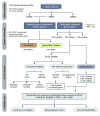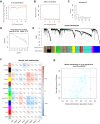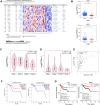Exploring Prognosis-Associated Biomarkers of Estrogen-Independent Uterine Corpus Endometrial Carcinoma by Bioinformatics Analysis
- PMID: 34876842
- PMCID: PMC8643178
- DOI: 10.2147/IJGM.S341345
Exploring Prognosis-Associated Biomarkers of Estrogen-Independent Uterine Corpus Endometrial Carcinoma by Bioinformatics Analysis
Abstract
Background: Uterine corpus endometrial carcinoma (UCEC) is one of the most common female cancers with high incidence and mortality rates. In particular, the prognosis of type II UCEC is poorer than that of type I. However, the molecular mechanism underlying type II UCEC remains unclear.
Methods: RNA-seq data and corresponding clinical information on UCEC patients were downloaded from The Cancer Genome Atlas database, which were then separated into mRNA, lncRNA, and miRNA gene expression profile matrix to perform differentially expressed gene analysis. Weighted gene co-expression network analysis (WGCNA) was used to identify key modules associated with different UCEC subtypes based on mRNA and lncRNA expression matrix. Following that, a subtype-associated competing endogenous RNA (ceRNA) regulatory network was constructed. In addition, GO functional annotation and KEGG pathway analysis were performed on subtype-related DE mRNAs, and STRING database was utilized to predict the interaction network between proteins and their biological functions. The key mRNAs were validated at the protein and gene expression levels in endometrial cancerous tissues as compared with normal tissues.
Results: In summary, we identified 4611 mRNA, 3568 lncRNAs, and 47 miRNAs as differentially expressed between endometrial cancerous tissues and normal endometrial tissues. WGCNA demonstrated that 72 mRNAs and 55 lncRNAs were correlated with pathological subtypes. In the constructed ceRNA regulatory network, LINC02418, RASGRF1, and GCNT1 were screened for their association with poor prognosis of type II UCEC. These DE mRNAs were linked to Wnt signaling pathway, and lower expression of LEF1 and NKD1 predicted advanced clinical stages and worse prognosis of UCEC patients.
Conclusion: This study revealed five prognosis-associated biomarkers that can be used to predict the worst prognosis of type II UCEC.
Keywords: WGCNA; competing endogenous RNA; estrogen-independent; prognosis; uterine corpus endometrial carcinoma.
© 2021 Ye et al.
Conflict of interest statement
The authors declare that they have no competing interests.
Figures








Similar articles
-
Identification of Hub Genes Correlated With Poor Prognosis for Patients With Uterine Corpus Endometrial Carcinoma by Integrated Bioinformatics Analysis and Experimental Validation.Front Oncol. 2021 Nov 19;11:766947. doi: 10.3389/fonc.2021.766947. eCollection 2021. Front Oncol. 2021. PMID: 34868993 Free PMC article.
-
Construction of dysregulated long non-coding RNA-associated competing endogenous RNA network in uterine corpus endometrial carcinoma.Transl Cancer Res. 2020 Feb;9(2):669-682. doi: 10.21037/tcr.2019.11.44. Transl Cancer Res. 2020. PMID: 35117412 Free PMC article.
-
Comprehensive bioinformatic analyses of lncRNA-mediated ceRNA network for uterine corpus endometrial carcinoma.Transl Cancer Res. 2022 Jul;11(7):1994-2012. doi: 10.21037/tcr-22-249. Transl Cancer Res. 2022. PMID: 35966302 Free PMC article.
-
Reconstruction and Analysis of the Differentially Expressed IncRNA-miRNA-mRNA Network Based on Competitive Endogenous RNA in Hepatocellular Carcinoma.Crit Rev Eukaryot Gene Expr. 2019;29(6):539-549. doi: 10.1615/CritRevEukaryotGeneExpr.2019028740. Crit Rev Eukaryot Gene Expr. 2019. PMID: 32422009 Review.
-
LINC01589 serves as a potential tumor-suppressor and immune-related biomarker in endometrial cancer: A review.Medicine (Baltimore). 2023 Apr 14;102(15):e33536. doi: 10.1097/MD.0000000000033536. Medicine (Baltimore). 2023. PMID: 37058060 Free PMC article. Review.
Cited by
-
Clinical Significance of NKD Inhibitor of WNT Signaling Pathway 1 (NKD1) in Glioblastoma.Genet Res (Camb). 2023 Mar 17;2023:1184101. doi: 10.1155/2023/1184101. eCollection 2023. Genet Res (Camb). 2023. PMID: 36969985 Free PMC article.
-
Expression and Significance of LINC02418 in Breast Cancer.Breast Cancer (Dove Med Press). 2024 Apr 24;16:233-243. doi: 10.2147/BCTT.S454054. eCollection 2024. Breast Cancer (Dove Med Press). 2024. PMID: 38694704 Free PMC article.
-
LINC02418 suppresses endometrial cancer progression via regulating miR-494-3p/RASGRF1 axis.J Mol Histol. 2025 Jan 22;56(1):72. doi: 10.1007/s10735-024-10327-w. J Mol Histol. 2025. PMID: 39841298
-
The interplay of sex steroid hormones and microRNAs in endometrial cancer: current understanding and future directions.Front Endocrinol (Lausanne). 2023 Apr 21;14:1166948. doi: 10.3389/fendo.2023.1166948. eCollection 2023. Front Endocrinol (Lausanne). 2023. PMID: 37152960 Free PMC article. Review.
-
Identification of Important Diagnostic Genes in the Uterine Using Bioinformatics and Machine Learning.Med J Islam Repub Iran. 2025 Jan 6;39:4. doi: 10.47176/mjiri.39.4. eCollection 2025. Med J Islam Repub Iran. 2025. PMID: 40486012 Free PMC article.
References
LinkOut - more resources
Full Text Sources
Other Literature Sources

